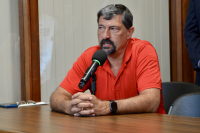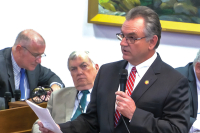The after action report: 50 fast facts from the Haywood election results

Two years ago, a Smoky Mountain News analysis of precinct-level elections results painted a portrait of a red county getting redder — at least electorally. This year was almost as rosy for Haywood’s Republican voters, who saw their candidates return to the U.S. House and the N.C. Senate as well as swing the Haywood Commission from a 3-to-2 Democratic majority to a 4-to-1 Republican advantage.
The only real blue blip in that rubescent picture was once and future Rep. Joe Sam Queen, the architect of a 2.7 percent increase in his vote totals over 2016, putting him back in the N.C. House over current and soon to be former Bryson City Republican Rep. Mike Clampitt.
That’s just one of a number of revealing facts culled from this year’s analysis of the unofficial election night vote totals as reported by the N.C. State Board of Elections and Ethics Enforcement; below, find 49 more.
N.C. 11th Congressional District
Despite being better organized and better financed than Asheville Republican Congressman Mark Meadows’ 2016 opponent, this year’s Democratic challenger Phillip Price didn’t fare much better in his effort to unseat Meadows, who will now begin his fourth term in the U.S. House.
2. In 2016, Meadows won district-wide by a margin of 28 points. In 2018, that margin shrank to 20 points.
Related Items
3. The only county of 16 Meadows lost in his district was Buncombe County, which is split between the 10th and 11th Congressional Districts; those 37 Buncombe precincts in the 11th District gave Price a 10-point victory over Meadows there.
4. This year, Meadows slipped 5 percentage points in Haywood County from 2016, when he earned 63 percent of the vote.
5. About 8.3 percent of Meadows’ 177,240 total votes came from Haywood County.
6. In Haywood County, Meadows lost two of 29 precincts this year — Lake Junaluska and Center Waynesville. In 2016, he only lost Center Waynesville.
7. First-time Libertarian candidate Clifton Ingram of Sylva earned 2.03 percent of votes across the district. In Haywood County he took 542 votes, good for 2.15 percent.
8. Ingram’s best-performing precinct in Haywood County was Big Creek, where he claimed 5.9 percent of the vote.
9. Only 17 votes were cast in Big Creek, the county’s smallest precinct by population; Ingram earned one.
N.C. Senate District 50
Franklin Republican Sen. Jim Davis cruised to a fifth term by more than 20 percentage points over Franklin Dem Bob Kuppers, but saw a slight erosion of support, especially in Jackson and Haywood counties.
10. This year, Davis won re-election with 60.3 percent of the vote overall, down more than two points from his 2016 total.
11. This is the second time in five elections that Davis’ percentage total didn’t increase over the previous election.
12. In Haywood County, Davis took 58.7 percent of the vote, compared to 59.5 percent in 2016.
13. Kuppers consequently performed about two points better district-wide than Davis’ 2016 opponent, Waynesville Democrat Jane Hipps, but in Haywood County the Macon County native Kuppers outperformed Hipps by about three-fourths of 1 percent.
14. In Haywood County this year, Kuppers won three of 29 precincts — Lake Junaluska, Center Waynesville and East Waynesville.
15. In 2016, Davis won every county in his district — Cherokee, Clay, Graham, Haywood, Macon and Swain and Jackson, which he won by 8.02 percent.
16. In 2018, Davis lost Jackson County by 1.7 percent (see #26, below).

N.C. House District 119
Bryson City Republican Rep. Mike Clampitt pulled off a stunning upset of incumbent Waynesville Democratic Rep. Joe Sam Queen in what was their third meeting and the second-closest legislative race on the 2016 ballot — winning by less than 300 votes but pulling off a roughly 1,400-vote swing from when he faced Queen in 2014. This year, it swung back, by roughly 1,400 votes.
17. In 2016, Queen was the only legislative incumbent on Haywood County ballots not to earn reelection.
18. In 2018, Clampitt was the only legislative incumbent on Haywood County ballots not to earn reelection.
19. Clampitt earned 50.4 percent of the district-wide vote in 2016, to Queen’s 49.6.
20. Clampitt earned 47.7 percent of the district-wide vote in 2018, to Queen’s 52.3.
21. As Haywood County is split between the 118th and 119th legislative districts, only 10 precincts (plus part of Ivy Hill) were in play for Queen, who won eight of them.
22. In 2016 and 2018, Queen took 52.34 and 52.95 percent of the Haywood County vote, respectively, a difference of 0.61 percentage points.
23. In 2016 and 2018, Clampitt took 47.66 and 47.05 percent of the Haywood County vote, respectively, a difference of 0.61 percentage points.
24. In 2016, Clampitt won Swain and Jackson counties, with Queen taking Haywood.
25. In 2016, Clampitt won Jackson County by 1.06 percent.
26. In 2018, Clampitt lost Jackson County by 8.74 percent (see #16, above).
N.C. House District 118
This district covers a significant chunk of Haywood County, as well as all of Burnsville Republican Rep. Michele Presnell’s home county, Yancey, and all of Madison County. Presnell again won all three, including challenger Rhonda Schandevel’s home county of Haywood.
27. District-wide, Presnell improved on her 2016 mark of 55.35 percent of the vote to 57.85 percent in 2018.
28. Only 18 of Haywood’s 29 precincts (and half of Ivy Hill) are in District 118, but this year, 45.9 percent of the ballots cast in this race came from Haywood. In 2016, that was 47.7 percent.
29. Presnell also improved on her 2016 performance in Haywood, growing from 54.82 percent of the vote to 57.85 percent.
30. For the second straight election, Schandevel didn’t even win her home precinct, Beaverdam 3.
31. In 2016, Schandevel won three Haywood precincts — Crabtree, Beaverdam 2 and Beaverdam 5/6.
32. In 2018, Schandevel won only Beaverdam 5/6.
Haywood County Commission
For the second election in a row, Republicans made gains on the commission, and for the second year in a row the ticket was led by a political newbie from the low end of the county (see EASTBOUND, page 7). In 2016, retiring Democrat Mark Swanger was replaced with Republican Brandon Rogers; this year, two of three available seats went to Republicans, giving them a majority for the first time ever, and a 4-to-1 majority at that.
33. Bethel Republican Tommy Long led all six candidates with 18.8 percent of the vote; he won 18 of Haywood’s 29 precincts, and tied for the lead in another.
34. Long’s best precinct-level performances came in Center Pigeon, Pigeon, East Fork and Cecil, where he pulled 28 percent of the vote.
35. Of Haywood’s 29 precincts, Long finished first or second in 24 of them.
36. Now the lone Democrat on the commission, current Chairman Kirk Kirkpatrick won 10 precincts, and tied with Long for the lead in another.
37. Kirkpatrick’s best precinct, percentage-wise, was Lake Junaluska.
38. Long finished 990 votes ahead of Kirkpatrick overall, with 12,959.
39. Beaverdam Republican Mark Pless didn’t win his home precinct of Beaverdam 1, but it was his best precinct performance by percentage.
39. Pless actually didn’t win any precincts, but did come in second in eight of 29.
40. Kirkpatrick bested Pless by 586 votes, but Pless topped Dem incumbent Commissioner Mike Sorrells for the third and final seat by just 43 votes, of more than 11,300 cast for each of them.
41. Sorrells recorded more absentee votes than any other commission candidate; all three Democrats (Kirkpatrick, Sorrells and Waynesville attorney Danny Davis) logged more absentee votes than all three Republicans (Long, Pless and Maggie Valley Alderman Phillip Wight).
42. Haywood County results from the races profiled herein show that the only Republican to beat their Democratic opponent in absentee voting was Rep. Presnell.
43. Haywood County results from the races profiled herein show that the only Republican to beat their Democratic opponent in early voting was Rep. Presnell.
44. The top four commission finishers — Long, Kirkpatrick, Pless and Sorrells — all finished within 2.36 percentage points of each other; coming in sixth of six, Wight was 3.85 points below Long, but just 1.49 percent away from claiming a seat.
Haywood County Tax Collector
Republican incumbent Mike Matthews is — or rather, was — probably the most controversial figure in this year’s local elections, with a number of Haywood public figures from both parties coming out both for and against him. Although 47.8 percent of voters came out for him, 52.2 percent came out against him, sweeping Democrat Greg West into an office many say shouldn’t be an elected position at all.
45. West won 17 of 29 precincts, mostly through the central urban core of Haywood County.
46. Matthews eked out a slim win in Ivy Hill, the county’s largest precinct in terms of voters.
47. More than 13 percent of West’s 1,071-vote margin of victory came from strong absentee and early voting support.
Voter turnout
No red wave, no blue wave — but it was a wave nonetheless; prior to the election, few candidates claimed to have any semblance of an idea of how it would all shake out on Election Day, and as it turns out, they were all correct.
48. In 2014, voter turnout in North Carolina was 44.35 percent. In 2018, it was 52.39 percent, or about 18 percent higher.
49. In 2014, voter turnout in Haywood County was 45.07 percent. In 2018, it was 56.39 percent, or about 25 percent higher.
50. The number of registered voters in Haywood County in 2018 grew 6.16 percent over 2014, from 42,448 to 45,063.









